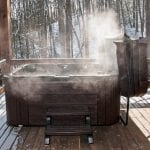FAQ
Here are some of the common questions we get, you're not alone.
You’re about to make a significant investment, one that could last for decades. Choosing the right dealer is a crucial part of the process. Look for an “Authorized Dealer” that has a relationship with the manufacturer of the pool you want to buy. That way, you know the dealer has access to the right training and materials to help you with your pool. Don’t be shy about asking the dealer for references. If you choose to use the dealer’s installation services, you should ask for photos or references from prior installation work. You’re about to upgrade your lifestyle and make significant changes to your property, so make sure you are comfortable with the dealer you’re working with!
- pH: 7.2 – 7.8
- Total Alkalinity: 80 – 120 ppm
- Calcium Hardness: 200 – 400 ppm
- Total Dissolved Solids: Below 1,500 ppm
Pool installation is a task often best handled by the experts. While most above ground pools are designed to be easy and fast to install, a professional installation crew can provide you with assurances regarding getting the job done right the first time. However, spring and summer are the most hectic time for pool installers, so it’s very important to set a schedule and book a crew early if you want to make the most of your pool for the entire season. Find out when the pool can be installed and how long it will take before you make your purchase.
It is hard to say just what constitutes “frequent” use of a hot tub.
Rule of Thumb: if you frequently use your hot tub, you should replace the water more often. In addition to the “Rule of Thumb” mentioned above, we suggest using our “Units of Usage” formula. This formula will help you calculate how much exposure your hot tub’s water has had to bathers & their body chemistry. We recommend you change your water after every 75 Units of Usage (uu).
The formula is easy to calculate & is based on the following equation:
1 person using a hot tub for 20 minutes = 1 uu
The rest is simple math: divide 75uu (without ozonation) or 125uu (with ozonation) by your weekly uu level to determine the number of weeks (rounded down to nearest whole week) between drainings of your hot tub. The following example should help you determine your own uu level on a weekly basis.
Example
2 people using a hot tub for 20 minutes, 3 times per week Weekly uu: 2 x 1 uu x 3= 6uu/week Weeks before draining: 75uu/6uu = 12.5 weeks
While this formula is a useful measuring tool, bear in mind that people perspire at different levels and that your water’s chemistry is just as unique as you are. If you are using an ozonator to help sanitize your water you may be able to reach a level between 90 and 125uu before changing your water. By the way, if a dog or cat should find its way into your tub, you may want to drain the water immediately. Unfortunately, pets produce bacteria at a rate approximately 50 times faster than humans.
Ask your pool dealer for recommendations regarding the right equipment for the above ground pool you choose. The size and type of your pool, will determine what size pump, what type of skimmer and so on. There are also many different types of pool cleaners, accessories and chemicals to choose from to make the most of your pool experience. Don’t be afraid to do your own research, but if you’ve found a dealer you can trust, have confidence that they will make the right recommendations for you and your pool.
Ask your pool dealer for recommendations regarding the right equipment for the above ground pool you choose. The size and type of your pool, will determine what size pump, what type of skimmer and so on. There are also many different types of pool cleaners, accessories and chemicals to choose from to make the most of your pool experience. Don’t be afraid to do your own research, but if you’ve found a dealer you can trust, have confidence that they will make the right recommendations for you and your pool.
The short answer is: It’s NOT the chlorine, it’s the copper.
Chlorine after all, is a bleach. When you add laundry bleach to the washing machine, it makes clothes whiter, removes discoloration and stains, and kills organisms – it does not make your clothes green, blue, turquoise or any other color. Any amount of chlorine in water more than about 15 ppm (parts per million) starts the bleaching process. Although typically a load of laundry in a washing machine has about 600 ppm of chlorine.
Copper can get into the pool or spa a number of different ways. First, drinking water (source or tap water) has a small amount of copper in it already. So each time makeup water is added due to evaporation, a little more copper is added. Since copper does not biodegrade or go away on its own, it builds up.
Second, some algaecides have as their active ingredient copper. The copper in algaecides usually has a special ingredient added to it that prevents it from staining people and vessels. This ingredient is called a chelating agent (pronounced KEY-lating) and copper algaecides that have this ingredient are said to be chelated. However, sunlight, constant high levels of chlorine or bromine, ozone, superchlorination and even non-chlorine shock treatments can oxidize the chelating agent. Once this happens, the copper stain protecting ability is decreased.
A third way copper gets into the pool is from the equipment. Water that has a low pH actually dissolves a small portion of the copper metal in components such as copper pipes, heater headers, heater heat sinks, bronze or brass pump parts such as impellers or volute assemblies, and even metals used in the filters. This is called corrosion. This small amount of copper gets dissolved from the equipment or components and then mixes with the main body of water in the pool or spa.
Another related way copper gets into the water is by water velocity through copper pipes and fittings. Water that is moving faster than the recommended velocity through a pipe will erode the pipe. This happens when too large of a pump is used on a system than it was designed for and sometimes when a solar water heating system is used for a pool or spa.
To remove the copper or other metals from the water, use a sequestering or chelating product. These are usually called metal inhibitors or metal removal products.
To remove the stain from hair or fingernails use one of the commercially available “chlorine removing” shampoos or enzyme products. You also could dilute a metal removal or inhibiting pool or spa chemical with a lot of water, apply to hair, leave on for a few seconds and rinse. This is not the best approach as these chemicals may damage the hair or get into eyes but, as a last resort and carefully, it could be done. Better to use a product designed for this purpose.
Cleaning of Pool Filters
While most people know that a filter is a key component of a swimming pool’s filtration system, quite a few do not realize that the filter needs to be cleaned periodically to insure proper equipment performance and cleanliness of the pool water. This article will discuss why maintenance cleaning is a good idea, then tell how to clean each of the 3 types of filters; cartridge, sand and finally both types of the Diatomaceous Earth (DE) filters.
When your filter was new the water could easily pass through it – the pounds of pressure per square inch (psi) shown on the filter’s pressure gauge probably read ~8 – 20, depending on your pool and plumbing set up. As the filter does its job and filters, the debris in the water gets removed, there is less room for more new debris and the pressure rises. When the pressure rises too much (usually 8 – 10 psi) it’s time to clean out the stuff that has already been captured in the filter so you have room to catch any new debris that enters the pool. Failure to keep the pressure in the normal range can result in cloudy water, poor circulation and excessive wear on the pool equipment.
To clean a cart filter, the pump must be turned off and any valves that would allow water to exit the pool should be closed. Open the drain port on the bottom of the filter and allow the water to empty, Then open the body of the filter (this may involve unscrewing some knobs, removing a nut at the top, or removing a bracket) and remove the cart or carts. Make sure you note their position and orientation so you have no trouble reassembling the unit! Rinse out the filter tank and take the carts to where you want to clean them. All you need is a garden hose with a nozzle. Wash the carts from the top to the bottom aiming ~ 45 degrees down at them. Please remember to wash both the outside portion and the inner portion – it’s a good idea to start at an identifying point on the cart and wash all the way around, then repeat on the inside. Once finished, reassemble the filter and open any valves you might have closed and you’re good to go until the pressure raises again.
Sand filters make use of a multiple position valve (multiport or multi) for cleaning the debris trapped by the sand. Whenever changing the position on a multi, you MUST have the pump off or you will break something. First make sure that any valve on the discharge line is open and any discharge hose is rolled out to where you want the dirty water to go. After turning off the pump, move the lever to the “BACKWASH” position and restart the pump. Most multis have a view glass so that you can see the debris coming out of the filter – when the water in the glass is ~ clear, turn off the pump and switch the multi to “RINSE” and run the pump for ~ 15 seconds. Repeat the “backwash/ rinse” cycles until the water comes out clear when you do the final backwash. Then reposition the valve back to the normal “FILTER” position, and you’re all set until the unit needs to be cleaned again. Please note that this process removes water from the pool, so be sure to keep an eye on the water level and don’t start the cleaning process if the water is already low! Some multis have the “BACKWASH” function, but not the “RINSE’, this is also true of multis with a pull up – push down handle – in either of these cases, a 10 second “FILTER” cycle can be used instead of the “RINSE”
DE filters come in 2 varieties, the first makes use of a multiport for the cleaning and the procedure is exactly the same as cleaning a sand filter. The only difference is that the DE is removed with the dirt and therefore you have to add more after cleaning the filter (sand is not removed when backwashing, so doesn’t need to be replaced). Because the backwashing doesn’t remove all of the DE only add ~80% of what the filter calls for when new or fully clean so that the filter doesn’t clog with clean DE.
The other kind of DE filter utilizes a handle on top of the filter to shift the internal assembly up and down to reduce the rise in pressure and is known as a “bump filter”. To recharge the DE, turn off the pump and open the air valve on the top for ~5 seconds and recluse it. Now slowly push the handle down and quickly raise it up 5 times. Restart the pump and check to see that the psi dropped more than 2. If it did, you’re all set and you don’t need to add any new DE to the filter. If it didn’t, repeat the bumping procedure, remove the plug from the bottom of the filter and run the pump another 30 seconds. Replace the plug, open the air valve on top and run the pump until water is coming out of the air valve. Do this whole process twice and you’ll be all set to add ~80% of what the filter calls for when new, just like the other type of DE filter.
Contact your city or municipality for applicable laws and regulations governing above ground pools – these may include the following:
- A building permit (not required in all areas, but you should always check)
- Safety standards (in certain regions)
- Utilities (electricity, laws governing when pools can be filled and drained, etc.)
- Laws regarding fencing and boundaries around a yard with a pool
- Boundaries of your property
Be sure to select a spot that is far from overhead or underground electrical lines and water and natural gas pipes and make sure you’re not putting your pool near any natural water sources.
Types of Pool Cleaners
A good pool filter is vital to creating good quality pool water that reduces the incidence of algae and helps maintain pH levels, alkalinity, and calcium hardness. Yet even the best pool filters will leave extra dirt and debris scattered about your pool.
An additional pool cleaner should be used once a week. This can be a time-consuming process unless you’re willing to invest in an automatic above ground or inground pool cleaner. These pool cleaners will allow you to enjoy your pool with minimal maintenance, making their investment and your investment in the pool itself worthwhile.
Inground or Above Ground Pool Cleaner?
The difference between inground and above ground pool cleaners is mostly about structure and range. The basic technology for each is essentially the same.
- Inground pool cleaners are built to facilitate the submerged nature of the pool and are often designed to work in depths up to eight feet.
- For deeper inground pools, a higher-end, specifically designed inground pool cleaner may be needed.
- Above ground pool cleaners are cheaper than their inground counterparts.
Above ground pool cleaners should work just as efficiently but, keep in mind, above ground pools often skimp on initial installation costs. Cutting these corners can put additional strain on both your pool filter and pump system and your pool cleaner. Before you invest in an above ground pool cleaner make sure your filter and pump system are up to par.
Types of Automatic Pool Cleaners
Suction-side
This pool cleaner uses the natural suction of your pool filter to create a vacuum for your pool cleaner. It is usually the cheapest and easiest to operate. Adversely, larger debris may cause the skimmer to clog. You may also need to play with different settings and set-ups to make sure your entire pool area is covered.
If your pool cleaning needs have mostly to do with dirt and not debris, a suction-side cleaner is the way to go. Cheap and reliable, this is also the best option for the casual or smaller pool owner.
Pressure-side
This pool cleaner uses the water pressure from the return hose of your filter to create its vacuum and to drive the pool cleaner around the pool. This hose attachment allows a pressure-side cleaner to distribute filtered throughout your pool. Its own collection bag also reduces the strain on your filter system, increasing its functionality and lifetime.
Making sure you empty this bag on a regular basis should allow this pool cleaner to take care of any the usual pool debris. Keep in mind you may need a booster pump to create adequate pressure.
Robotic
This pool cleaner has a self-contained filtration system and operates completely independently of your pool pump and filter. These devices can clean your pool faster and more effectively than other cleaners. It can be programmed or operated by remote control to customize their cleaning for your specific pool.
If you have a larger pool or areas that can be difficult to clean, the extra expense of this pool cleaner can be easily justified.
Weekly Maintenance Keeps Your Pool Clean and Safe
For a safe and fun experience, be sure to thoroughly clean your pool every week during the swimming season. Here are some tips to keep you on track.
Skim Off Leaves and Debris
Use a long-handled leaf skimmer to gather up leaves, insects, and any other debris floating on the surface of the pool. Try to remove debris before it sinks to the bottom of your pool where it becomes difficult to remove and may create stains.
Brush
Use a brush to remove dirt that has collected on the sides and bottom of your pool. Brush sediment toward the main drain so it can be easily vacuumed.
Vacuum
Submerge your vacuum head and hose, before hooking up the vacuum to the filter.
Clean Skimmer(s)
You should also clean out your skimmer(s) weekly or more often if necessary. Removing debris allows the skimmer to operate at maximum efficiency.
Check Water Circulation
Your pool’s circulation system includes the skimmer, pump, pump strainer, drains, and filter. The system helps chemicals work effectively and ensures that water is properly filtered. Run your pump long enough each day to make sure the water is properly filtered and keep each item clean and in good condition.
Check Filter
The three most popular types of filters — sand, cartridge, and vertical grid DE — screen out debris and particles from your pool water. You should clean and maintain your filter according to the manufacturer’s directions.
Shock
Test your pool water frequently (daily or weekly depending on use) and add chemicals if necessary, following manufacturers’ directions. A regular shock treatment cleanses the water of algae, bacteria, dirt, and any other organic matter that may have entered the pool. Follow manufacturer’s directions for shock treatments
Suspended micro particulate matter, interfering with the passage of light is known as turbidity. It can range from an almost imperceptible haziness to a pure, milky white color. Besides being unattractive, cloudy water can prevent the rescue of swimmers in trouble and may provide no depth perception for those who would dive into the water. This particulate matter also interferes with the ability of the filter and chemicals to properly sanitize the water.
This particulate matter can be carbonates and sulfates forced out of solution by imbalanced water, perhaps worsened by the introduction of high temperatures. The situation could also be the result of poor filtration and sanitation programs. It can indicate a problem with the effectiveness of the filter or the amount of time its allowed to run each day or it may point to sanitizer residuals being too low or inconsistently applied. Finally, cloudy water may result from pool water which has reached saturation. High TDS levels may not permit any more solids from being dissolved or saturated into solution.
Use of clarifiers, or chitin products such as Sea-Klear work to coagulate smaller particles into larger, filterable clumps. Use of these products are a helpful boost to your sanitation and filtration program, and are especially necessary in pools with undersized or inefficient circulation/filtration systems.
For extremely cloudy pools, shocking with lithium or sodium hypochlorite, followed by constant filtration with the use of clarifiers may be the best solution to the problem. If not, you may want to drain some of the water and dilute with less saturated fill water and / or use a flocculent to settle suspended material to the bottom for vacuuming.
Even though you put chemicals in the spa, skin, hair and bacteria can build up in the plumbing lines.
We recommend that you “purge” the lines every year. A good product is actually called “spa purge” and you should use it before the next water change.
Any hot tub is subject to freezing during colder weather. If any water is left in a spa (or in the lines, pumps, or fittings) that is not operating properly, the water can freeze, which will cause serious damage to your hot tub. And here’s the important part: Any damage that is caused by freezing IS NOT covered by your warranty.
Your best bet is to leave the spa running. All spas with a computerized control center have a “freeze protection mode” that prevents damage to the spa in cold temperatures.




